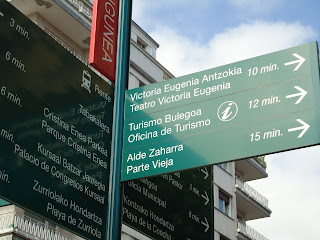
Interstingly, foral law seems to us today to have been well in advance of its time when it was codified in the middle ages. It was among the first legal codes to abolish torture and debtors´prison. Citizens were protected against unwarranted arrest and arbitrary house searches. To keep land together, widows were favored over children and the eldest child, male or female, was the principal inheritor of the family estate. The major flaw in this system was that, as time advanced and industrialism grew, it greatly favored the rural Basque over the urban Basque.
Every year, in his role as King of Castille, el rey (there was no official title "King of Spain" until relatively recently) came to the Basque province of Viscaya and, under the famous tree of Guernica, would promise to respect the foral laws.
But with the French Revolution came great change in Europe. The idea of a permanent, single, monolingual, united nation under republican principles began to displace the ancient notion of a patchwork of peoples and languages living under the rule of a monarch whose laws were mutable and negotiable. In the early 1800´s Napoléon I invaded, overthrew the Spanish monarchy and imposed his reluctant brother Joseph on the Spanish peoples as José I.
Bonaparte also imposed a national constitution. This constitution, coming as it did at the dawn of the modern era, greatly favored the urban, industrial, commercial Basque. Basques had almost never been completely unified during the many international conflicts over the centuries but for the next one hundred and fifty years, events would see urban and rural Basque violently squared off against each other in crisis after crisis as the 19th century became the 20th and nationalism gave birth to fascism and nazism.
To mitigate the devastations of this deep division, Sabino Arana also created a national flag. Based on the Union Jack (the British have long had a strong presence in Euskal Herria), the ikurriña, comprises a red background which symbolizes the people, criss-crossed by a white cross which symbolizes the Catholic Church and the purity of Christ, and diagonal green bars which symbolize the fuera, the ancient laws.
For most of the 20th century, this flag and the language of the Basques itself was outlawed in Spain. Flying the first or speaking the latter could easily lead to imprisonment and even death under Franco´s rule.
Speaking Spanish at home, she was enrolled in a Basque school. Everywhere, Spain was tasting, breathing and living a freedom it hadn´t known in almost half a century. Naroa grew up at liberty to live her Basque heritage in a way her parents never had.
Euskara, by the way, is muy dificile. It is utterly unlike Spanish or French. Or any other language in Europe. It does have cases like German. There are no regular verbs but very few verbs are actually conjugated. The few that are conjugated serve as auxiliary verbs for all of the other verbs. That´s the good news. The not-so-good news is that everything in English or French that does not change, such as nouns or articles or subject pronouns, change in Euskara depending on who is speaking, what the subject is, what the object is, etc. Two weeks is only enough time to get a taste but hardly enough time to even begin to digest this ancient and mysterious language.

 All signage in Donostia is bilingual. Euskera first, Spanish second. The charm of this beautiful town can be seen here. It is assumed these signs are being read by pedestrians because who would want to drive or take a bus here if he could possibly help it? The distances on these signs are measured in minutes (by foot), not kilometers.
All signage in Donostia is bilingual. Euskera first, Spanish second. The charm of this beautiful town can be seen here. It is assumed these signs are being read by pedestrians because who would want to drive or take a bus here if he could possibly help it? The distances on these signs are measured in minutes (by foot), not kilometers. Here is one of my favorite places in all of Donostia, la plaza de la Constitución or la Consti for short. With the ultimate imposition, in the 1840´s, of a national Spanish constitution on all Spanish territories and the end of foral law, the change was reflected in the architecture and planning of the town. La Consti was, at the time, the biggest square in the town and it remains one of the city´s largest. I think it´s the most beautiful. The balconies are numbered because, althought the apartments behind them were always private homes, the municipality retained the right to sell balcony space to spectators for bull fights which were given in the square below. Today this brutal sport is happily absent from this beautiful space, but the numbers remain.
Here is one of my favorite places in all of Donostia, la plaza de la Constitución or la Consti for short. With the ultimate imposition, in the 1840´s, of a national Spanish constitution on all Spanish territories and the end of foral law, the change was reflected in the architecture and planning of the town. La Consti was, at the time, the biggest square in the town and it remains one of the city´s largest. I think it´s the most beautiful. The balconies are numbered because, althought the apartments behind them were always private homes, the municipality retained the right to sell balcony space to spectators for bull fights which were given in the square below. Today this brutal sport is happily absent from this beautiful space, but the numbers remain.




In this one blog post alone, I've learned so much about the Basque people! Thank you for the detail with which you write and the history you provide. It seems your fellowship inspires already!
ReplyDelete